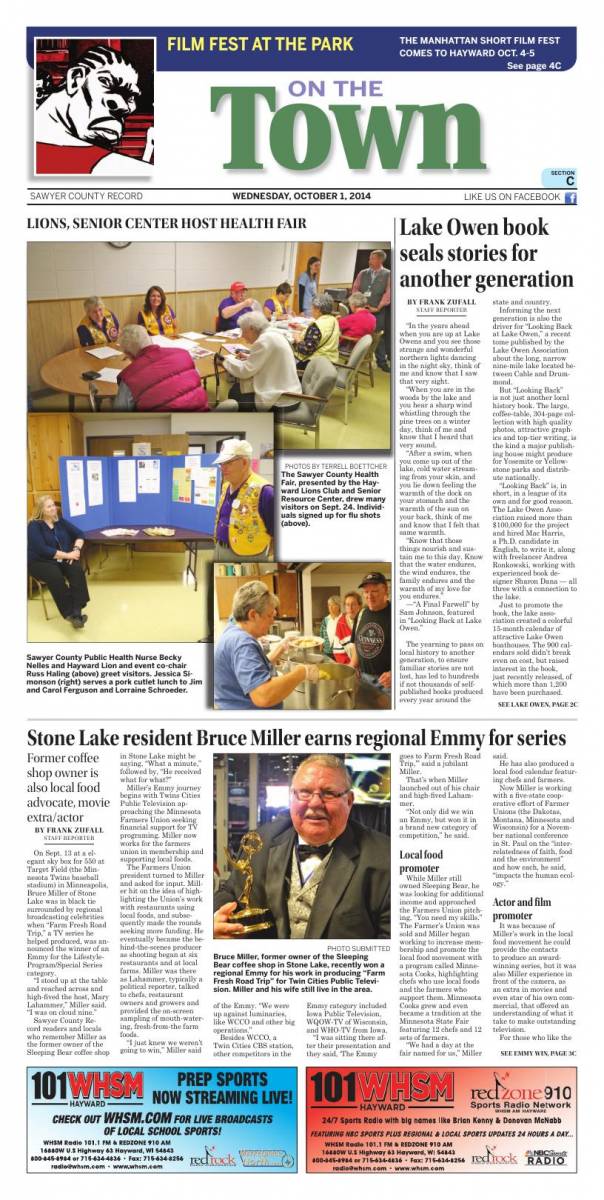Lake Owen book seals stories for another generation
By Frank Zufall
Staff Reporter
Sawyer County Record
“In the years ahead when you are up at Lake Owens and you see those strange and wonderful northern lights dancing in the night sky, think of me and know that I saw that very sight.
“When you are in the woods by the lake and you hear a sharp wind whistling through the pine trees on a winter day, think of me and know that I heard that very sound.
“After a swim, when you come up out of the lake, cold water streaming from your skin, and you lie down feeling the warmth of the dock on your stomach and the warmth of the sun on your back, think of me and know that I felt that same warmth.
“Know that those things nourish and sustain me to this day. Know that the water endures, the wind endures, the family endures and the warmth of my love for you endures.”
—“A Final Farwell” by Sam Johnson, featured in “Looking Back at Lake Owen.”
The yearning to pass on local history to another generation, to ensure familiar stories are not lost, has led to hundreds if not thousands of self-published books produced every year around the state and country.
Informing the next generation is also the driver for “Looking Back at Lake Owen,” a recent tome published by the Lake Owen Association about the long, narrow nine-mile lake located between Cable and Drummond.
But “Looking Back” is not just another local history book. The large, coffee-table, 304-page collection with high quality photos, attractive graphics and top-tier writing, is the kind a major publishing house might produce for Yosemite or Yellowstone parks and distribute nationally.
“Looking Back” is, in short, in a league of its own and for good reason. The Lake Owen Association raised more than $100,000 for the project and hired Mac Harris, a Ph.D. candidate in English, to write it, along with freelancer Andrea Ronkowski, working with experienced book designer Sharon Dana — all three with a connection to the lake.
Just to promote the book, the lake association created a colorful 15-month calendar of attractive Lake Owen boathouses. The 900 calendars sold didn’t break even on cost, but raised interest in the book, just recently released, of which more than 1,200 have been purchased. Ralph Owen, Jon Nymo and Terry Miller are three lake association board members behind “Looking Back,” but they say the idea came from two other lake residents, Bruce Hendry and Bill Hannaford, two men who worried as long-term lake residents were passing their stories were being lost forever.
A book committee was formed and decision made to pursue a “high-class coffee table, hard-bound book,” Nymo said. Much of the book is family history – those with century-long ties, like the Owens, and those with just decades, like Millers. “Everybody, if they chose, could be recognized and their history could be put in for their grandkids,” Miller said.
Several Lake Owens family names are well known, not only for having a long foothold on the lake but also because of family success in business, like the Johnson family of SC Johnson Corporation.
“There was concern that it was only going to be about the legacy families,” Nymo said.
“There were critics who said it was going to be an elitist deal,” Miller added. “That was not our intention, and our final project shows exactly what we intended it to be.”
Not surprisingly, the Lake Owen story unfolds chronologically.
Local author, historian and guide, Dave Thorson, wrote one of the first chapters, “An Irregular, Romantic Lake,” recounting the forces of ancient geology that shaped the landscape, including the glacial lobes, followed by the arrival of Native Americans and early Europeans and the introduction of railroads, logging and tourism.
In pursuit of the big pine forest, the first legacy family story begins with the arrival of Johns S. Owen in 1873. Owen spent a summer camping on an island before becoming a force in logging, including association with the Drummond sawmill. In 1889, he built a log cabin on the lake that stills stands today.
A Racine connection led to other legacy families, such as the Johnsons and Horlicks of Horlick’s Malted Milk and Horlick’s Foods, all building their get-away retreat at the lake near friends.
One of the famous lake residents was Albert Dunlap, former chief executive of Scott Paper and Sunbeam, a business leader notorious for axing employees and cutthroat tactics, behaviors which, the book chronicles, Dunlap also displayed at the lake.
A few celebrity lake visitors over the years have included actor Jimmy Stewart, former U.S. Supreme Court Justice Sandra Day O’Connor and several Olympians who attended the former Lake Owen Gymnastic and Cheer camp, including 2012 American gold medalist Gabby Douglas. Gangster John Dillinger showed interest in a lakeside property but never purchased.
The book moves forward telling stories through the decades of families and individuals while also noting the development of the lake region.
“It’s all been extremely positive,” Nymo said about the book. “The pictures are worth the price of admission. Anyone you ask about the book, they say ‘I’ve learned so much. I’ve lived here so long and I didn’t know all that.’ My wife has been coming up here 40 years and I’d ask her, ‘Why didn’t you tell me that?’ and she’d say, ‘I didn’t know that.’”
Miller said the younger generation is finding out about the earlier generation’s experience on the lake.
“My main motivation was to do this for my grandchildren,” Miller said. “You have things like the railroad station. Well that’s gone. The tracks are gone. That’s history. Those kids wouldn’t know something like that unless they had something like this to read. Half the families on the lake used to cut their ice in the winter and use it in the summer. Our grandkids, if they don’t read that, they don’t know that. There’s just a lot we are hoping to hand out to the next generation.”
The three men say the book’s appeal is more than just the history, but the lake itself, designated the most pristine in the state, a body of water that not only inspires poems but the desire to preserve it for future generations.
“I think they see something as close to perfection as they will ever see and they want to make sure it stays that way,” Miller said.
“The lake is the main character of the book,” Nymo added. “That’s why everyone is here. It’s not just a place where you play with your neighbor. You come up to be on the lake or near the lake or to be involved around the lake.”
Availability
“Looking Back at Lake Owen” is only available at Redberry Books in Cable. Call (715) 798-5014 or visit www.redberrybooks.com.



